NVIDIA nForce4 Ultra: Biostar's Performance Surprise
by Gary Key on February 16, 2006 12:05 AM EST- Posted in
- Motherboards
FSB Overclocking Results
Updated 955EE Testing
Memory Stress Testing
Memory stress tests look at the ability of the Biostar TForce4 U 775to operate at the officially supported memory frequencies of 667MHz DDR2, at the best performing memory timings that the Corsair CM2X512A-5400UL revision 1.3 will support.
The Biostar TForce4 was very stable with 2 DDR2 modules in Dual-Channel at the settings of 3-2-2-8 at 2.1V. We will now install all four available memory slots that result in more strenuous requirements on the memory subsystem than testing 2 DDR2 modules on a motherboard.
The Biostar TForce4 was completely stable with 4 DDR2 modules in Dual-Channel operation at the settings of 3-3-3-8, but required the command rate to be increased to 2T. We tried several combinations of memory settings at the 3-2-2-8 settings, but the board was not stable enough to complete our test suite.
| Front Side Bus Overclocking Testbed | |
| Processor: | Pentium 4 Smithfield LGA 775 840EE Dual Core 3.2GHz |
| CPU Voltage: | 1.4825V (1.4000V default) |
| Memory Settings: | 3-2-2-8 at 667MHz |
| Memory Voltage: | 2.1V |
| SPP Voltage: | 1.58V |
| FSB Voltage: | 1.40V |
| Cooling: | Thermaltake Big Typhoon |
| Power Supply: | OCZ Power Stream 520 |
| Maximum CPU OverClock: | 250fsb x 17 (4250MHz) +33% |
| Maximum FSB OverClock: | 255fsb x 16 (4092MHz) +27% |
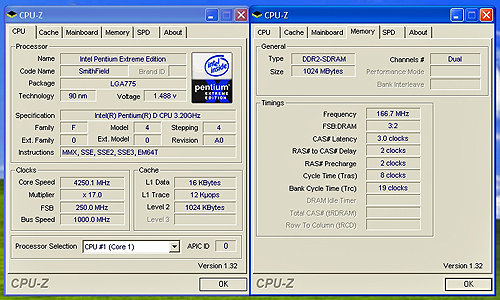
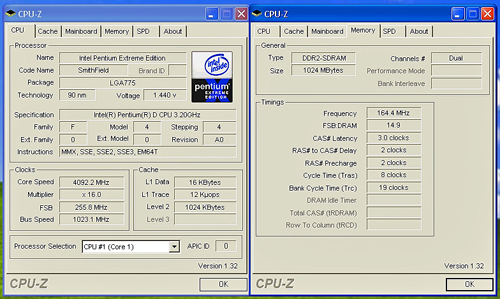
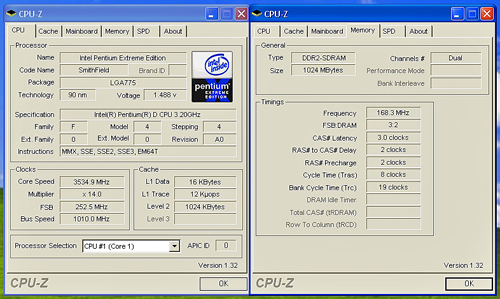
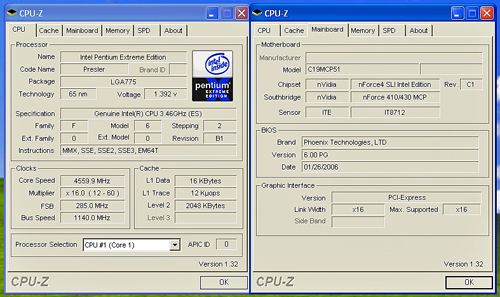
Updated 955EE Testing
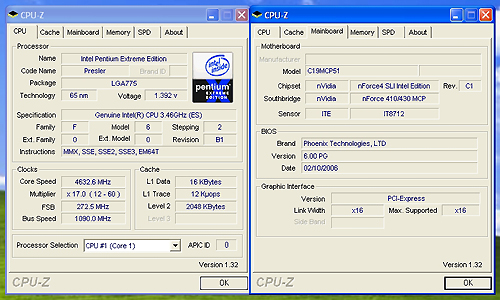
Memory Stress Testing
Memory stress tests look at the ability of the Biostar TForce4 U 775to operate at the officially supported memory frequencies of 667MHz DDR2, at the best performing memory timings that the Corsair CM2X512A-5400UL revision 1.3 will support.
| Biostar TForce4 U 775 Stable DDR667 Timings - 2 DIMMs (2/4 slots populated - 1 Dual-Channel Bank) |
|
| Clock Speed: | 200MHz (800FSB) |
| Timing Mode: | 667MHz - Default |
| CAS Latency: | 3 |
| RAS to CAS Delay: | 2 |
| RAS Precharge: | 2 |
| RAS Cycle Time: | 8 |
| Command Rate: | 1T |
| Voltage: | 2.1V |
The Biostar TForce4 was very stable with 2 DDR2 modules in Dual-Channel at the settings of 3-2-2-8 at 2.1V. We will now install all four available memory slots that result in more strenuous requirements on the memory subsystem than testing 2 DDR2 modules on a motherboard.
| Biostar TForce4 U 775 Stable DDR667 Timings - 4 DIMMs (4/4 slots populated - 2 Dual-Channel Banks) |
|
| Clock Speed: | 200MHz (800FSB) |
| Timing Mode: | 667MHz - Default |
| CAS Latency: | 3 |
| RAS to CAS Delay: | 3 |
| RAS Precharge: | 3 |
| RAS Cycle Time: | 8 |
| Command Rate: | 2T |
| Voltage: | 2.10V |
The Biostar TForce4 was completely stable with 4 DDR2 modules in Dual-Channel operation at the settings of 3-3-3-8, but required the command rate to be increased to 2T. We tried several combinations of memory settings at the 3-2-2-8 settings, but the board was not stable enough to complete our test suite.










31 Comments
View All Comments
Ecmaster76 - Thursday, February 16, 2006 - link
If they do they might acually catch up with AMD.Supposedly their CSI project is falling apart. If they swallow their pride their server department would find a boon in HT